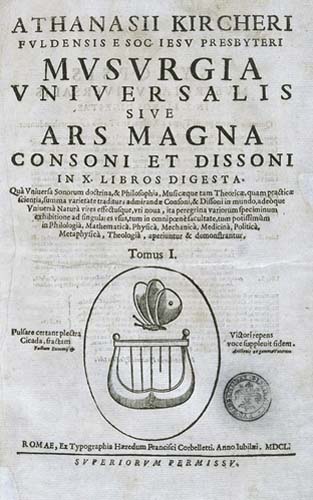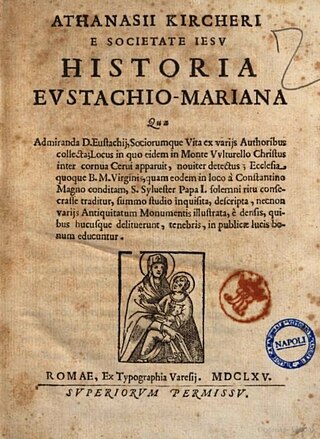
The magic lantern, also known by its Latin name lanterna magica, was an early type of image projector that used pictures—paintings, prints, or photographs—on transparent plates, one or more lenses, and a light source. Because a single lens inverts an image projected through it, slides were inserted upside down in the magic lantern, rendering the projected image correctly oriented.

A camera obscura is a darkened room with a small hole or lens at one side through which an image is projected onto a wall or table opposite the hole. The image of lensless camera obscuras is also referred to as "pinhole image".

Athanasius Kircher was a German Jesuit scholar and polymath who published around 40 major works of comparative religion, geology, and medicine. Kircher has been compared to fellow Jesuit Roger Joseph Boscovich and to Leonardo da Vinci for his vast range of interests, and has been honoured with the title "Master of a Hundred Arts". He taught for more than 40 years at the Roman College, where he set up a wunderkammer. A resurgence of interest in Kircher has occurred within the scholarly community in recent decades.
The year 1665 in science and technology involved some significant events.

Musurgia Universalis, sive Ars Magna Consoni et Dissoni is a 1650 work by the Jesuit scholar Athanasius Kircher. It was printed in Rome by Ludovico Grignani and dedicated to Archduke Leopold Wilhelm of Austria. It was a compendium of ancient and contemporary thinking about music, its production and its effects. It explored, in particular, the relationship between the mathematical properties of music with health and rhetoric. The work complements two of Kircher's other books: Magnes sive de Arte Magnetica had set out the secret underlying coherence of the universe and Ars Magna Lucis et Umbrae had explored the ways of knowledge and enlightenment. What Musurgia Universalis contained, through its exploration of dissonance within harmony, was an explanation of the presence of evil in the world.
Paleontology or palaeontology is the study of prehistoric life forms on Earth through the examination of plant and animal fossils. This includes the study of body fossils, tracks (ichnites), burrows, cast-off parts, fossilised feces (coprolites), palynomorphs and chemical residues. Because humans have encountered fossils for millennia, paleontology has a long history both before and after becoming formalized as a science. This article records significant discoveries and events related to paleontology that occurred or were published in the year 1665.

A projector or image projector is an optical device that projects an image onto a surface, commonly a projection screen. Most projectors create an image by shining a light through a small transparent lens, but some newer types of projectors can project the image directly, by using lasers. A virtual retinal display, or retinal projector, is a projector that projects an image directly on the retina instead of using an external projection screen.

Lightwave is the ambient music project of keyboardists Christoph Harbonnier and Christian Wittman, founded in 1984 in Paris, France. They have collaborated with a plethora of artists, such as Hector Zazou, Michel Redolfi, Jon Hassell and Paul Haslinger.

China Illustrata is the 1667 published book written by the Jesuit Athanasius Kircher (1602–1680) that compiles the 17th-century European knowledge on the Chinese Empire and its neighboring countries. The original Latin title is Athanasii Kircheri e Soc. Jesu China monumentis, qua sacris qua profanis, nec non variis Naturae et artis spectaculis, aliarumque rerum memorabilium argumentis illustrata, auspiciis Leopoldi primi, Roman. Imper. Semper augusti Munificentissimi Mecaenatis.

Turris Babel was a 1679 work by the Jesuit scholar Athanasius Kircher. It was the last of his books published during his lifetime. Together with his earlier work Arca Noë, it represents Kircher's endeavour to show how modern science supported the Biblical narrative in the Book of Genesis. The work was also a broad synthesis of many of Kircher's ideas on architecture, language and religion. The book was dedicated to the Holy Roman Emperor Leopold I and printed in Amsterdam by the cartographer and bookseller Johannes van Waesbergen.

Ars Magnesia was a book on magnetism by the Jesuit scholar Athanasius Kircher in 1631. It was his first published work, written while he was professor of ethics and mathematics, Hebrew and Syriac at the University of Würzburg. It was published in Würzburg by Elias Michael Zink.

Historia Eustachio Mariana is a 1665 work by the Jesuit scholar Athanasius Kircher. It describes his chance discovery of a ruined shrine of the Virgin Mary at Mentorella, the site where tradition held that the Roman martyr Saint Eustace had experienced conversion to Christianity. The book was dedicated to Giovanni Nicola, abbot of the monastery at Vulturalla, and a member of the family of the counts of Poli. It was intended to help raise funds for the restoration of the chapel, and it was Kircher's first topographical work.

Itinerarium exstaticum quo mundi opificium is a 1656 work by the Jesuit scholar Athanasius Kircher. It is an imaginary dialogue in which an angel named Cosmiel takes the narrator, Theodidactus, on a journey through the planets. It is the only work by Kircher devoted entirely to astronomy, and one of only two pieces of imaginative fiction by him. A revised and expanded second edition, entitled Iter Exstaticum, was published in 1660.

Polygraphia nova et universalis ex combinatoria arte directa is a 1663 work by the Jesuit scholar Athanasius Kircher. It was one of Kircher's most highly regarded works and his only complete work on the subject of cryptography, although he made passing references to the topic elsewhere. The book was distributed as a private gift to selected European rulers, some of who also received an arca steganographica, a presentation chest containing wooden tallies used to encrypt and decrypt codes.

Scrutinium Physico-Medicum Contagiosae Luis, Quae Pestis Dicitur is a 1658 work by the Jesuit scholar Athanasius Kircher, containing his observations and theories about the bubonic plague that struck Rome in the summer of 1656. Kircher was the first person to view infected blood through a microscope, and his observations are described in the book. The work was printed on the presses of Vitale Mascardi and dedicated to Pope Alexander VII.

Obeliscus Pamphilius is a 1650 work by the Jesuit scholar Athanasius Kircher. It was published in Rome by Ludovico Grignani and dedicated to Pope Innocent X in his jubilee year. The subject of the work was Kircher's attempt to translate the hieroglyphs on the sides of an obelisk erected in the Piazza Navona.

Magnes sive de Arte Magnetica is a 1641 work by the Jesuit scholar Athanasius Kircher. It was dedicated to Emperor Ferdinand III and printed in Rome by Hermann Scheuss. It developed the ideas set out in his earlier Ars Magnesia and argued that the universe is governed by universal physical forces of attraction and repulsion. These were, as described in the motto in the book's first illustration, 'hidden nodes' of connection. The force that drew things together in the physical world was, he argued, the same force that drew people's souls towards God. The work is divided into three books: 1.De natura et facultatibus magnetis, 2.Magnes applicatus, 3.Mundus sive catena magnetica. It is noted for the first use of the term 'electromagnetism'.

Latium is a 1669 work by the Jesuit scholar Athanasius Kircher. It was dedicated to Pope Clement X and a 1671 edition was published in Amsterdam by Johannes van Waesbergen. The work was the first to discuss the topography, archeology and history of the Lazio region. It was based partly on Kircher's extensive walks in the countryside around Rome, although it included sites that he had probably not visited in person. The work included many illustrations of the contemporary countryside, as well as reconstructions of ancient buildings. It also included an account of his discovery of the ruined sanctuary at Mentorella, which he had already recounted in his 1665 work Historia Eustachio Mariana.

Arithmologia, sive De Abditis Numerorum Mysteriis is a 1665 work by the Jesuit scholar Athanasius Kircher. It was published by Varese, the main printing house for the Jesuit order in Rome in the mid-17th century. It was dedicated to Franz III. Nádasdy, a convert to Catholicism to whom Kircher had previously co-dedicated Oedipus Aegyptiacus. Arithmologia is the only one of Kircher's works devoted entirely to different aspects of number symbolism.

Diatribe de progidiosis crucibus is a 1661 work by the Jesuit scholar Athanasius Kircher. It was printed in Rome by Blasius Deversin and dedicated to Archduke Leopold Wilhelm of Austria. A second edition of the work was published in Rome in 1666 and a German translation appeared in Gaspar Schott's Joco-seriorum naturae et artis.

















